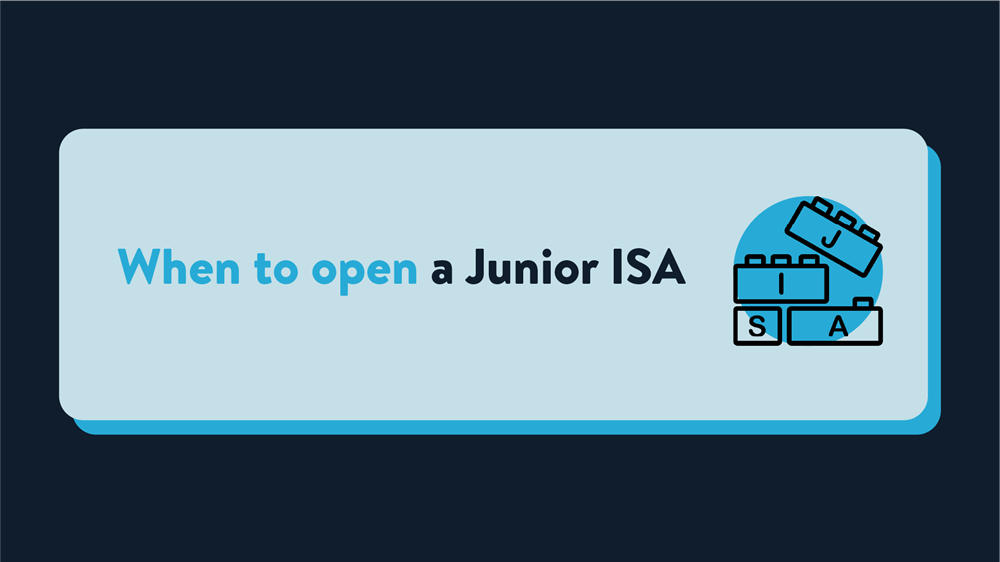Birthdays, festive events, pocket money, newspaper rounds, chores; by the time your child turns 18, they could have accumulated some serious dough.
A pot of savings that could pave the way for a bright financial future and a positive first step towards their relationship with money.
And while you may be anticipating regular tugs at your shirt asking for cash during their teens, giving them the opportunity to build their wealth and financial understanding before then could be highly beneficial.
Junior ISAs are a great way to save or invest for a child if you’re considering the tax-free benefits they bring. Here’s what you need to know about timings:
- When to start saving for your child
- Best way to save for children
- When is it too late to save for your child?
![]()
When to start saving for your child
The sooner the better is a general rule of thumb when it comes to saving for your children. Though unfortunately, this isn’t always possible for everyone — there may be more pressing financial matters, or you’re simply not in a position to put money away for the long term.
But if you are in the position to start saving, then it could be worth putting money away for your child before they’re even born. Babies are expensive and there’s lots that you’ll need to buy in anticipation for them — from pushchairs, to cribs, to safety catches for drawers and doors. All of this can add up, but if you financially prepare for it beforehand then it shouldn’t come as such a surprise.
Once they’re born you could open them their very own Junior ISA and start building up savings for their future.
If you’re considering a Junior ISA, then it’s worth noting that once the money is paid in it belongs to your child and it’ll stay there until they turn 18. That means you can’t use it as a way to save for their birthday presents or school uniform, or any other immediate treats or needs. This is more for helping them with their first home, buying a car, or travelling the world.
What age can you open a Junior ISA?
Junior ISAs can be opened for the child from birth. And from that moment onwards, your child should benefit from the power of compounding interest, and all money held within it is tax-free.
The account stays open until the day before their 18th birthday; after then, the account would simply ‘mature’ into an adult version of an ISA for them to access and manage.
While you won’t be able to withdraw money or close the account manually before the child turns 18, you are able to transfer to another provider at any time.
It may be worth shopping around occasionally to check your child is getting good interest rates or returns, low fees, and that you’re satisfied with the overall service.
Your child’s tax treatment will depend on individual circumstances and may be subject to change in the future.
Best way to save for children
Whether you want to get them on the property ladder, help them unlock further education, or just let them build the pot you’ve already saved; saving for your child’s future gives them a world of opportunity. And you have the option to save and/or invest in the process of getting them.
For example, saving £35 every month from birth until your child is 18 could work out to be £7,595.
But by investing it in a Wealthify Junior Stocks and Shares ISA instead, this is estimated to be £10,831 depending on market performance [2].
You can choose to open a:
- Junior Cash ISA
- Junior Stocks and Shares ISA
- Or one of each type.
It’s important to note though, that your child can only ever have one of each type open at any time (i.e. one Junior Cash ISA, and/or one Junior Stocks and Shares ISA).
You can deposit a combined total of up to £9,000 across both accounts during each tax year (although this allowance is subject to change in the future).
![]()
Saving for children
Saving cash for your child in a Junior Cash ISA offers you a rate of interest that builds on top of the money held. As the value increases, the compounding interest would be building up, too.
The benefit of a Junior Cash ISA is that the money within it (including the interest) is tax-free. But the downside is that the interest rate may not match the rate of inflation over the years. That’s a common reason why people opt for investing, rather than saving cash.
Investing tends to be a long-term strategy, usually needing at least 5 years to ride out the market’s highs and lows. For that reason, you could say opening a Junior Cash ISA is better for short-term savings for children aged 14 or over (short-term being less than 5 years).
Keep in mind that the money will still be locked in until the child turns 18, regardless of whether you choose a Junior Cash ISA or Junior Stocks and Shares ISA.
Note: Wealthify doesn’t offer a Junior Cash ISA; our Junior ISA product is a Junior Stocks and Shares ISA.
Investing for children
A Junior Stocks and Shares ISA could be a solution for longer-term investing, as this is typically recommended for a minimum of 5-10 years. The hopes are that the time spent invested, plus the dividends and interest that your child earns over the years (which are also reinvested), all build up to a more lucrative amount in the pot by the time they turn 18.
It also gives plenty of time for the money invested to ride out the natural highs and lows you’d expect to see from the stock market.
By that logic, you could consider starting a Junior Stocks and Shares ISA as the better choice for long-term investing, say if your child is aged between birth to 13 years old.
That’s not to say you need to swap the funds out after they turn 14 — it’s just that between the age of 13 to 18 would sensibly be the minimum 5 years marker that many people aim to invest for. You don’t have to stick to this as a hard rule, it’ll be whatever you are comfortable with.
(With a Junior ISA, your capital is at risk, and your child could get back less than invested.)
When is it too late to save for your child?
It’s never too late to start saving for your child! However, how you choose to do this may change based on their age.
If your child is still under 18 – but isn’t a little kid anymore and is quickly approaching adulthood – then you could try to save larger amounts more regularly (if you can afford to). But this doesn’t have to mean putting aside huge amounts either.
For example, if you could save £200 a month from the time your child turns 16, then they could have £5,304 when their Junior Stocks and Shares ISA matures at 18 (just two years later!) [3].
With Wealthify, their Junior ISA would automatically mature into an adult Stocks and Shares ISA at that time, allowing them to continue investing if they wished to build on your positive example.
(With investing, your capital is at risk.)
Invite family members or close friends to help
Some Junior ISA providers, like Wealthify, let you invite friends or family to contribute to the Junior ISA, too.
For example, if your child has a grandparent who is keen to help them build their finances, they can contribute up to the £9,000 allowance with you.
Set them up as a regular Contributor with Wealthify and let them deposit regularly or as a one-off. Either way, they can leave a little note to explain who the money came from and why, as a memento for your child to look back on and smile.
You can keep building wealth for them
Even when they are all grown up and ready to fly the nest, there’s still plenty of time to save and help contribute to their big life events like a wedding or first home if you wish to.
While you’ll no longer be able to access their ISA once they’re an adult — you would still be able to use your own ISA account(s) and tax-free ISA allowance (which is currently £20,000 per tax year), to continue the good saving/investing habit for them.
There are plenty of options on the table to help your little one grow into the financially confident adult you hope they’ll become.
With a Junior ISA, your capital is at risk and your child could get back less than invested.
Wealthify does not provide financial advice. Please seek financial advice if you are unsure about investing.
Your tax treatment will depend on your individual circumstances, and it may be subject to change in the future.
References:
2: This is the projected value for a Confident Plan (Medium Risk Plan) with an Original theme. This is only a forecast and is not a reliable indicator of future performance. If markets perform worse, your return could be £8,290. If markets perform better, your return could be £14,315. Values correct as of 31/03/2025.
3: This is the projected value for a Confident Plan (Medium Risk Plan) with an Original theme. This is only a forecast and is not a reliable indicator of future performance. If markets perform worse, your return could be £4,886. If markets perform better, your return could be £5,682. Values correct as of 31/03/2025.



